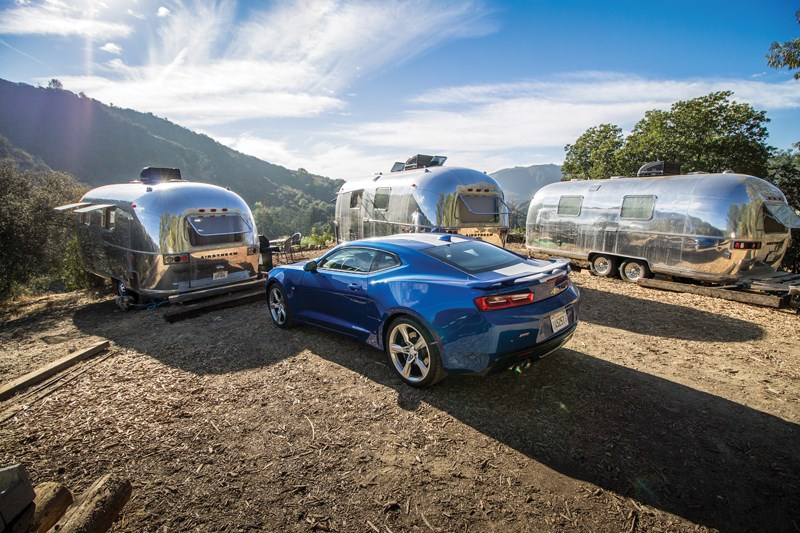Last week found me living as a TV detective on the outskirts of Los Angeles.
I’m not sure what my show was called (can I get a crime-solving dog named Cheese? Mac and Cheese? Every Tuesday at 7 p.m. on NBC), but there I was anyway. I lived in an Airstream on the edge of a cliff, and drove a Camaro SS.
Of course, all this was but a fantasy. The Airstream was an AirBnb oddball find, and the Camaro was just a car I managed to borrow for covering the various events surrounding the Los Angeles Auto Show. I took it to the Hot Wheels design studio, the Petersen Automotive Museum, the Mooneyes hot rod shop, Mullholland Drive, and the canyons.
At 50, the Camaro is at once modern and ridiculously old school. This one sported a Mustang-trumping 455 horsepower small-block Chevy V-8, a manual transmission, and a cockpit designed by a guy who must build coastal defense pillboxes in his spare time. Seriously, it would be easier to see out of a Canada Post mailbox on wheels than this Camaro.
So, not quite as easy to live with day-to-day as a Mustang, but there are some advantages. For one thing, the current Camaro is basically a 2+2 version of the Corvette. Road & Track did some instrumented testing of a similarly equipped manual Camaro SS and it ran to 100 kilometres per hour and through the quarter-mile within a few tenths of a second of the ‘Vette, before pulling about 1g on the skidpad.
When the Camaro was launched in September of 1966, GM’s marketing team claimed that the car was named for a word meaning friend or companion. Then they joked that a Camaro was “a small, fierce animal that eats Mustangs.”
Certainly the Camaro’s intended target couldn’t have been more obvious. Ford fans often turn up their noses at the Camaro because it was a response to a success rather than a totally original idea. The Camaro gets called an imitator a lot.
However, I prefer to drag up an old maxim to describe this car: you can’t sharpen steel on butter. The rivalry between the Camaro and the Mustang shouldn’t have the mindless vitriol of, say, politics, but rather the acknowledgment that competition improves the breed.
At launch, the first generation Camaro arrived with fastback coupe styling and a host of engine options. Things got really interesting towards the end of the 1960s, when the Z/28 package cars showed up.
Equipped with a 302 cubic inch (4.9-litre) V-8, this really was the agile beast to slay the Mustangs. Probably the most famous of them was the Penske-Donohue Lightweight, a ‘67 racer that had been dipped in acid to reduce weight. Clocking in at a little more than 1,100 kg, it was about 15 per cent lighter than the standard race car. After a bit of skullduggery to get the car to pass scrutineering (it’s only cheating if you get caught was the order of the day), the Lightweight ran at Sebring and beat the pants off cars like the Ford GT40s and a Ferrari LM.
Ever since that victorious debut, the Camaro vs. Mustang fisticuffs have developed a certain rhythm. Ford will put out a standard car. Chevrolet will respond with a faster version. The Blue Oval will release some stripped-down Shelby track-rat. Chevy will counter with an insanely powerful version, usually with whatever’s currently the best Corvette engine under the hood. Ford’ll come up with a supercharged something-or-other to combat the big-dog Camaro, and the Bowtie boys will hit them back with a bare-bones race car for the streets.
On Ford’s side, we had Carroll Shelby’s racing specials and the emergence of the iconic 5.0 badge. On the Camaro side we had the triumphant SS, the IROC, and the wedge-tastic F-Body platform. The Camaro took a bit of a breather between 2002 and 2010, but it roared back in its fifth generation just in time to take advantage of a wave of nostalgia for retro-themed styling.
If you haven’t picked sides, this is a lot of fun: kinda like watching a heavyweight match between two fighters and secretly rooting for them both. Rivalries like the Mustang vs. Camaro wars end up leaving room for others to sneak up: the Dodge Challenger, for instance, which leaves lap time records on the table and opts for straight-line speed and cruiser comfort.
After a couple of days in the Camaro, I’d gotten used to the tank-like visibility and fallen head over heels with the chassis. This is a fantastic car, and hammers home the feeling that the Cadillac ATS should have had a V-8 option.
Even when measured next to the Mustang Shelby GT350, a very special car, it’s advantage Camaro. The Mustang’s more livable, but the Camaro’s tightly controlled body motions give it a dynamic advantage. It also looks far fiercer than its pony car rival.
With the coming ZL1 model for the Camaro, and a potential Shelby GT500 on the horizon, both automakers are ramping up for a showdown of epic proportions. You can expect 600+ h.p. engines from each, suspension technology worthy of the world-class endurance racing efforts of both companies, and lightning fast transmissions.
So, while the Camaro still has a whiff of Kojack and the Rockford Files about it, it’s also evolved from pony car to full-on sports car. At 50, it’s still ready to take a bite out of any Mustang it can catch off guard.
Brendan McAleer is a freelance writer and automotive enthusiast. If you have a suggestion for a column, or would be interested in having your car club featured, please contact him at [email protected]. Follow Brendan on Twitter: @brendan_mcaleer.



